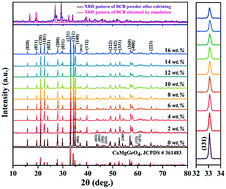Effects of BaCu(B2O5) additives on the crystal structures and dielectric properties of CaMgGeO4 ceramics for LTCC applications
Abstract
A CaMgGeO4 (CMG) ceramic with an olivine structure was fabricated by the traditional solid-phase reaction method; this material was dense at 1300 °C/6 h and exhibited excellent dielectric properties (εr = 6.83, Q × f = 125 432, f = 14.9 GHz). The effects of BaCu(B2O5) (BCB) on the sintering characteristics, crystal structures and microwave dielectric properties of CMG systems were studied. BCB can effectively reduce the sintering temperature (Ts) of the CMG ceramic, and when the amount of BCB is 16 wt%, the Ts can be lowered to 875 °C. The CMG ceramic containing 8 wt% BCB shows excellent dielectric properties (εr = 7.01, Q × f = 73 962, f = 14.8 GHz) at 940 °C/6 h. Raman mode 11 moves to a lower wavenumber with increasing BCB content, while the BCB content has the opposite effect on the dielectric constant; however, the full width at half-maximum (FWHM) value of mode 11 correlates negatively with the Q × f values. In addition, the change in the packing fraction is similar to that in the Q × f values with increasing BCB content. A decrease in the packing fraction means an increase in the vibrational space and possibly non-resonance, which in turn reduces the Q × f value. In addition, the ceramic has good chemical compatibility with the Ag electrode, indicating broad application prospects in low-temperature co-fired ceramics (LTCCs) for CMG.



 Please wait while we load your content...
Please wait while we load your content...